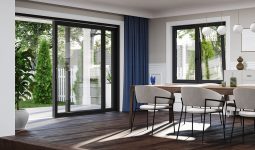When it comes to the different types of flooring, there is a wide range of materials to choose from, each with its own set of benefits and drawbacks.
Flooring is a crucial aspect of any home or commercial space as it serves a functional purpose and significantly impacts the overall aesthetic of the space.
Whether you are looking for a sustainable and eco-friendly option. A budget-friendly option, or a durable and long-lasting option, there is a flooring option that will meet your needs.
However, each type of flooring has unique advantages and disadvantages. From hardwood to tile, carpet to vinyl, and linoleum to cork.
This article will explore the different types of flooring available, detailing their benefits and drawbacks and helping you make an informed decision about the best flooring option for your space.
1. Carpet Flooring
Carpet flooring is most popular in homes, offices, and commercial spaces. This flooring provides a warm and soft surface for walking, making it a great choice for bedrooms and living rooms. Carpet flooring is made from synthetic fibers like nylon, polyester, and olefin or natural fibers like wool.
The type of fiber used affects the durability and stain resistance of the carpet. Carpet flooring is available in various colors, textures, and patterns, making it a versatile option for different interior design styles. However, carpet flooring requires regular maintenance, including vacuuming and deep cleaning, to keep it looking its best.
2. Hardwood Flooring
Hardwood flooring is a timeless and classic choice for homes and commercial spaces. This type of flooring is made from solid wood planks, such as oak, maple, and cherry. And is available in various colors, finishes, and stains.
Also, Hardwood flooring is known for its durability and long-lasting beauty. Making it a popular choice for high-traffic areas like entryways and hallways. However, it is important to note that hardwood flooring is prone to scratches and dents and can be sensitive to moisture..
Additionally, it is also sensitive to temperature changes, making it important to take proper care and maintenance measures. This is one of the different types of flooring.
3. Laminate Flooring
Laminate flooring is one of the different types of flooring, and it is a cost-effective alternative to hardwood flooring that provides the look and feel of real wood without the high price tag. Also, this type of flooring is made from a high-density fiberboard core and a decorative top layer that mimics the look of natural wood or stone.
Laminate flooring is highly durable, resistant to scratches and stains, and easy to clean. Making it a popular choice for kitchens, bathrooms, and other high-traffic areas. However, laminate flooring is less warm and comfortable than carpet or hardwood flooring. And there may be better choices for areas where noise reduction is important.
4. Tile Flooring
Tile flooring is popular for kitchens, bathrooms, and other high-moisture areas. This flooring type is one of the different types made from various materials, including ceramic, porcelain, and natural stone.
Tile flooring is highly durable and resistant to water and stains, making it a great choice for areas subject to heavy use and moisture. Additionally, tile flooring is available in a wide range of colors, patterns, and finishes, making it a versatile option for different interior design styles.
However, tile flooring can be cold and hard underfoot; also, it can be expensive to install. This is one of the different types of flooring.
5. Vinyl Flooring
Vinyl flooring is a budget-friendly and versatile option popular in homes and commercial spaces. The popular vinyl flooring is made from a waterproof synthetic material resistant to scratches, dents, and stains.
Vinyl flooring is available in various patterns and colors, including those that mimic the look of natural wood and stone. Making it a popular choice for those who want to achieve the look of more expensive flooring options without the high cost.
Additionally, vinyl flooring is easy to clean and maintain, making it a great choice for high-traffic areas. However, vinyl flooring can be less durable than other flooring options. And there may be better choices for areas with heavy foot traffic or heavy furniture. This is one of the different types of flooring.
6. Bamboo Flooring
Bamboo flooring is a very sustainable and eco-friendly option growing in popularity. This type of flooring is made from the bamboo plant’s stalk, a fast-growing and renewable resource. Also, Bamboo flooring is available in various colors and finishes, including those that mimic the look of hardwood flooring.
Bamboo flooring is known for its durability and resistance to scratches and dents, making it a great choice for high-traffic areas. Interestingly, bamboo flooring is easy to clean and maintain, making it a popular choice for homes and commercial spaces.
However, bamboo flooring may not be as durable as other flooring options, such as hardwood or tile, and it may be more expensive than other budget-friendly options, such as vinyl flooring. This is one of the different types of flooring.
7. Concrete Flooring
Concrete flooring is a versatile and durable option growing in popularity in both homes and commercial spaces. This concrete type of flooring is made from a mixture of cement, water, and aggregate materials and can also be finished with various treatments, including staining, sealing, and polishing.
Concrete flooring is known for its durability and resistance to moisture. Making it a great choice for areas with heavy foot traffic and furniture. Additionally, concrete flooring is easy to clean and maintain and can be affordable for those looking for a low-maintenance flooring solution.
However, concrete flooring can be cold and hard underfoot, and there may be better choices for areas that require insulation or noise reduction. This is one of the different types of flooring.
8. Cork Flooring
Cork flooring is a sustainable and eco-friendly option that is growing in popularity. This type of flooring is made from the bark of the cork oak tree, and this flooring types known for its durability and resistance to moisture.
Cork flooring is also soft and warm underfoot. Making it a great choice for areas where comfort is important, such as bedrooms and living rooms. Additionally, cork flooring is available in various colors and finishes, including those that mimic the look of hardwood flooring, making it a versatile option for different interior design styles.
However, cork flooring may be more expensive than other flooring options, and it may require special care and maintenance to keep it looking its best. This is one of the different types of flooring.
9. Linoleum Flooring
Linoleum flooring is a sustainable and eco-friendly option made from natural materials, including linseed oil, cork dust, and wood flour. Also, this type of flooring is known for its durability and resistance to moisture, making it a great choice for areas with heavy foot traffic and furniture.
Linoleum flooring is also available in various colors and finishes, including those that mimic the look of tile and hardwood flooring. Making it a versatile option for different interior design styles. However, linoleum flooring may be more expensive than other flooring options. And it may require special care and maintenance to keep it looking its best.
10. Stone Flooring
Stone flooring is a luxurious and durable option made from natural stone, including marble, granite, and slate. This flooring type is known for its durability and resistance to moisture, making it a great choice for areas with heavy foot traffic and furniture.
Stone flooring is also available in various colors and finishes, making it a versatile option for different interior design styles. However, stone flooring may be expensive to install and require special care and maintenance to keep it looking its best. Stone flooring can be cold and hard underfoot. Making it less comfortable than other options, such as carpet and cork flooring.
11. Engineered Wood Flooring
Engineered wood flooring is a popular option made by combining multiple layers of wood with a top layer of solid hardwood. This engineered type of flooring is known for its durability, versatility, and resistance to moisture, making it a great choice for homes and commercial spaces.
Engineered wood flooring is available in various colors and finishes. Including those that mimic the look of hardwood flooring, making it a versatile option for different interior design styles. Additionally, engineered wood flooring is easy to install and maintain, making this type a popular choice for those looking for a low-maintenance flooring solution.
However, solid hardwood flooring may be less durable than engineered wood flooring and may be more expensive than other budget-friendly options, such as laminate flooring.
12. Rubber Flooring
Rubber flooring is a durable and versatile option made from recycled rubber tires. This flooring type is known for its moisture resistance. Making it a great choice for areas with heavy foot traffic and furniture, such as kitchens, bathrooms, and laundry rooms.
Rubber flooring is also available in various colors and finishes, making this type a versatile option for different interior design styles. Additionally, rubber flooring is soft and warm underfoot, making it a great choice for areas where comfort is important, such as bedrooms and living rooms.
However, rubber flooring may be more expensive than other flooring options and may not be as visually appealing as other options, such as hardwood or tile flooring. This is one of the different types of flooring.
In conclusion, when it comes to the different types of flooring options. There is a wide range to choose from, each with its unique benefits and drawbacks. Whether you are looking for a sustainable and eco-friendly option or a budget-friendly option. Or a durable and long-lasting option, there is a flooring option that will meet your needs.
From hardwood to tile, carpet to vinyl, and linoleum to cork. Each type of flooring has advantages and disadvantages that you should consider before deciding. However, it is important to consider the amount of foot traffic the space will receive, the level of maintenance you are willing to invest in, and your overall design aesthetic.
Additionally, it may be beneficial to seek the advice of a flooring professional who can offer insight and recommendations based on your specific needs and budget. Ultimately, the type of flooring you choose will greatly impact your space’s overall look, feel, and functionality, so choose wisely and enjoy your beautiful new floors for years to come!








